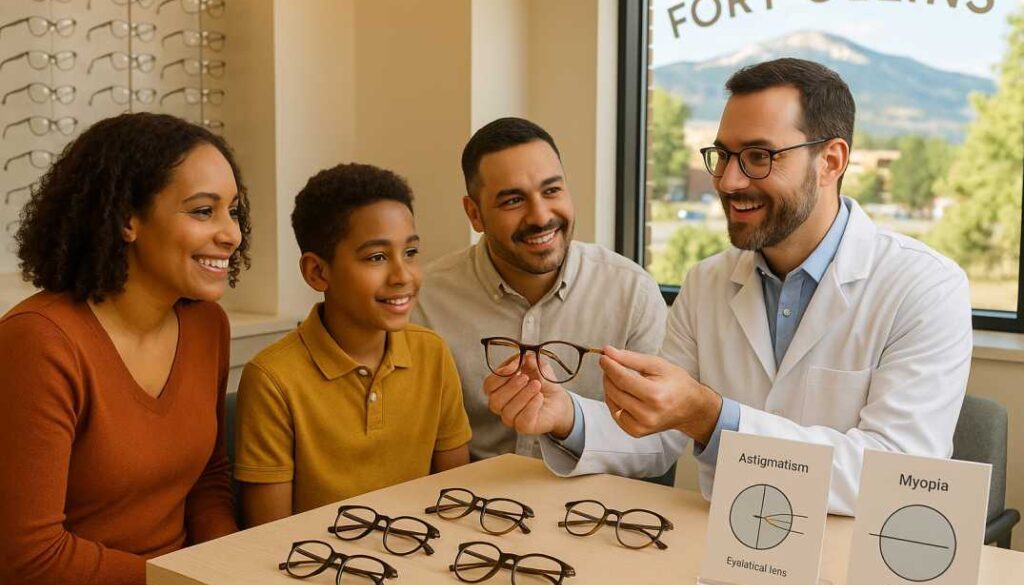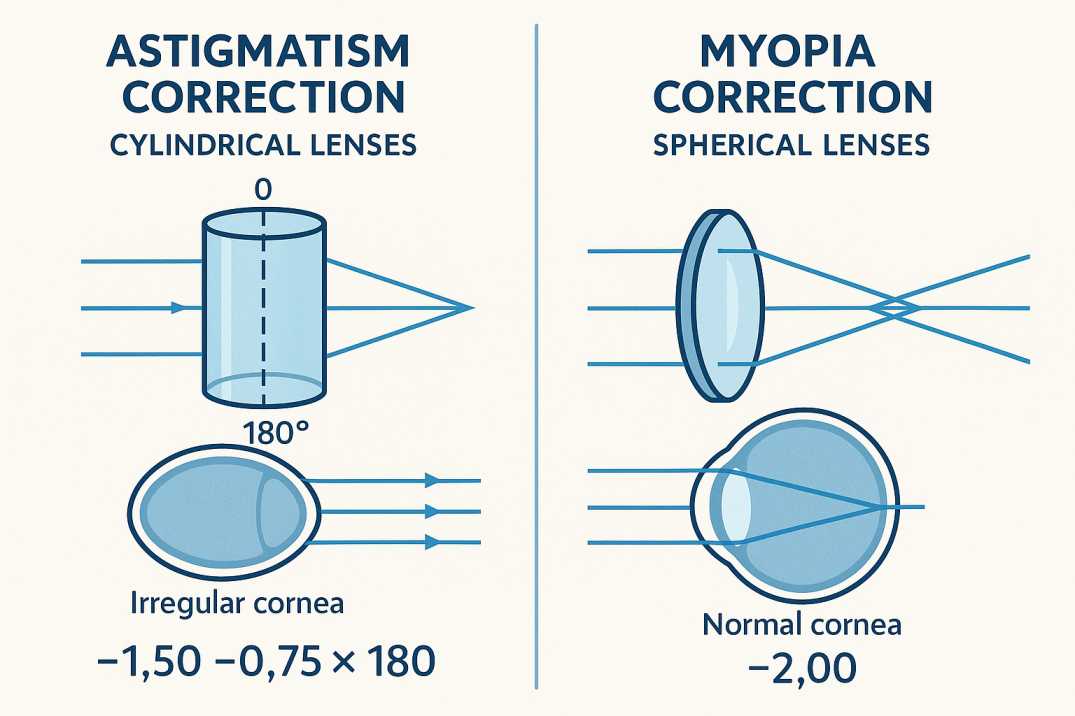Glasses for Astigmatism vs. Myopia Explained
If you’ve ever wondered why your glasses prescription includes different numbers and letters, or why your friend’s nearsighted glasses won’t help your astigmatism symptoms, you’re not alone. Understanding the key differences between glasses for astigmatism and glasses for myopia can help you make informed decisions about your eye care and ensure you’re getting the right prescription lenses for your specific vision needs.
At Poudre Valley Eyecare, we’ve spent over 25 years helping Fort Collins families understand their vision prescriptions and find the perfect eyewear solutions. Let’s break down everything you need to know about these two common vision conditions and their distinct correction requirements.
Understanding the Fundamentals: Astigmatism vs. Myopia
What is Astigmatism?
Astigmatism occurs when your cornea (the clear front surface of your eye) has an irregular, non-spherical shape. Instead of being perfectly round like a basketball, an astigmatic cornea is more oval-shaped, resembling the back of a spoon. This irregular curvature causes light rays to focus at multiple points rather than a single point on your retina, resulting in blurred or distorted vision at all distances.
What is Myopia (Nearsightedness)?
Myopia, commonly called nearsightedness, happens when your eyeball is too long or your cornea is too curved. This causes light to focus in front of your retina instead of directly on it, making distant objects appear blurry while close-up vision remains clear.
The Prescription Lens Difference: Cylindrical vs. Spherical Correction
Glasses for Astigmatism: Cylindrical Lenses
When you have astigmatism, you’ll need prescription lenses with cylindrical or spherocylindrical correction. These specialized lenses are designed to compensate for the uneven corneal shape by providing different optical powers in different meridians of the lens.
Your astigmatism prescription will include:
- CYL (Cylinder): The lens power needed to correct your astigmatism, ranging from -0.25 to -4.00 or higher
- Axis: A number between 1 and 180 degrees that indicates the orientation of your astigmatism correction
Glasses for Myopia: Spherical Lenses
Myopia correction uses spherical lenses with uniform curvature across the entire surface. These “minus power lenses” are concave-shaped (thinner in the center, thicker at the edges) and work by reducing the eye’s focusing power to move the focal point back onto the retina.
Your myopia prescription will show:
- SPH (Sphere): A negative number (like -2.00) indicating the lens power needed to correct nearsightedness
- The higher the number, the stronger your prescription
Key Differences in Prescription Lens Design
Lens Technology
Astigmatism Correction:
- Requires cylindrical lens surfaces
- Cannot be corrected with over-the-counter reading glasses
- Often combined with spherical correction for compound prescriptions
- May require specialized lens materials for higher prescriptions
Myopia Correction:
- Uses simple spherical lens surfaces
- Standard single-vision design for most cases
- High-index materials recommended for prescriptions stronger than -3.00D
- An anti-reflective coating is highly beneficial to reduce lens reflections
Frame Considerations
For Astigmatism:
- Flatter frame styles work better than wraparound designs
- Proper bridge fit is crucial for maintaining lens orientation
- Frame stability is important to prevent axis rotation
For Myopia:
- More flexibility in frame choice
- Smaller frames can reduce lens thickness for high prescriptions
- Consider lens edge thickness with stronger prescriptions
When You Have Both: Compound Prescriptions
Many people have both astigmatism and myopia simultaneously. Your prescription will include both spherical and cylindrical corrections:
Example prescription: -2.50 -1.00 x 180
- -2.50: Myopia correction
- -1.00: Astigmatism correction
- 180: Axis orientation
The Latest Research: Evidence-Based Lens Technologies
Recent scientific studies have provided compelling evidence for advanced prescription lens designs:
Study 1: Myopia Control Effectiveness (2022)
A comprehensive systematic review of 12 randomized controlled trials found that specialized myopia control lenses showed significant effectiveness in slowing progression. Highly aspherical lenslets (HAL) demonstrated 70% refractive and 60% axial length efficacy, while defocus incorporated multiple segments (DIMS) lenses showed 50-60% control effect compared to standard single-vision lenses.
Study 2: Long-term Safety and Efficacy (2023)
A six-year study published in Scientific Reports demonstrated that children wearing DIMS spectacle lenses maintained consistent myopia control effectiveness over extended periods. The research showed no significant safety concerns and continued benefit in slowing myopia progression, with participants experiencing 0.32mm less axial elongation compared to traditional lenses.
Study 3: Next-Generation Astigmatism Correction (2024)
Recent research on asymmetric myopic peripheral defocus lenses for combined astigmatism and myopia correction showed promising results. The study found that specialized lens designs could reduce myopia progression by up to 43% while maintaining excellent visual acuity and comfort for astigmatism correction.
Lens Material Options and Enhancements
For Astigmatism
- Standard plastic: Suitable for mild to moderate astigmatism
- High-index lenses: Recommended for astigmatism greater than ±4.0 diopters
- Anti-reflective coating: Essential for reducing glare and improving vision quality
- Polycarbonate: Excellent choice for active lifestyles
For Myopia
- High-index materials: Significantly thinner for prescriptions stronger than -3.00D
- Anti-reflective coating: Reduces unsightly power rings and improves appearance
- Blue light filtering: May help with digital eye strain from screen use
- Photochromic options: Convenient transition from clear to tinted outdoors
Symptoms and When to Seek Professional Care
Astigmatism Symptoms:
- Blurred or distorted vision at all distances
- Eye strain and fatigue
- Headaches, especially after visual tasks
- Squinting to see clearly
- Difficulty with night vision
- Halos or starbursts around lights
Myopia Symptoms:
- Clear near vision but blurry distance vision
- Squinting to see distant objects
- Headaches from eye strain
- Difficulty seeing the board at school or road signs while driving
- Eye fatigue after looking at distant objects
Treatment Options Beyond Traditional Glasses
For Progressive Myopia
- Myopia control lenses: Specialized designs that slow progression in children
- Orthokeratology: Overnight contact lenses that temporarily reshape the cornea
- Low-dose atropine drops: Pharmaceutical intervention to slow progression
- Multifocal contact lenses: Designed specifically for myopia control
For Astigmatism
- Toric contact lenses: Weighted contacts that maintain proper orientation
- Scleral lenses: Large-diameter lenses for irregular astigmatism
- Refractive surgery: LASIK or PRK for permanent correction
- Specialty rigid gas permeable lenses: For complex or high astigmatism
Cost Considerations and Insurance Coverage
Understanding the financial aspects of prescription lenses helps you make informed decisions:
Traditional Single-Vision Lenses:
- Basic plastic lenses: $50-$100
- High-index materials: $100-$300
- Premium coatings: Additional $50-$150
Specialized Myopia Control Lenses:
- DIMS or HAL technology: $200-$400
- Often covered partially by vision insurance
- Long-term investment in eye health
Insurance and Medicare: At Poudre Valley Eyecare, we accept Medicare and Medicaid, making quality vision care accessible to our entire community. We’ll work with your insurance to maximize your benefits and help you understand your coverage options.
Choosing the Right Eye Care Provider
When selecting glasses for astigmatism or myopia, professional expertise makes a significant difference. Here’s what to look for:
Comprehensive Eye Examination:
- Detailed refractive assessment
- Corneal topography for astigmatism mapping
- Retinal health evaluation
- Binocular vision testing
Technology and Equipment:
- Modern diagnostic tools like retinal imaging
- Precise measurement capabilities
- Access to the latest lens technologies
- Custom fitting services
Experience and Expertise:
- Quarter-century of experience like our team at Poudre Valley Eyecare
- Specialized knowledge in pediatric and adult vision care
- Understanding of complex prescriptions
- Ongoing education in the latest treatments
Pediatric Considerations: Children’s Vision Needs
Early Detection Importance: Children may not realize their vision isn’t optimal, making regular eye exams crucial. We recommend comprehensive vision screening by age 3, with follow-ups based on our assessment.
Myopia Control Priority: With childhood myopia rates increasing dramatically, early intervention can prevent high myopia and associated complications later in life. Our specialized pediatric programs focus on both correction and progression control.
Astigmatism in Children: Many children are born with mild astigmatism that may improve naturally. However, significant astigmatism should be corrected early to prevent amblyopia (lazy eye) development.
Digital Age Considerations
Screen Time Impact: Extended digital device use doesn’t cause myopia or astigmatism, but can worsen symptoms. Consider:
- Blue light filtering lenses
- The 20-20-20 rule: Every 20 minutes, look at something 20 feet away for 20 seconds
- Proper screen positioning and lighting
- Regular breaks from close-up work
Modern Lens Enhancements:
- Anti-fatigue designs for computer users
- Progressive lenses for presbyopic patients with astigmatism or myopia
- Specialized coatings for harsh lighting conditions
Prevention and Lifestyle Modifications
Protecting Your Vision:
- Spend time outdoors, especially for children
- Maintain proper lighting for reading and computer work
- Follow the 20-20-20 rule during screen time
- Wear UV-protective sunglasses
- Eat foods rich in vitamins A, C, and E
- Stay hydrated for optimal eye health
Regular Monitoring: Even with perfect glasses, regular eye exams remain essential for:
- Detecting prescription changes
- Monitoring eye health
- Early identification of eye diseases
- Updating treatments based on new research
The Future of Vision Correction
Emerging Technologies:
- Smart glasses with adjustable focus
- Advanced myopia control treatments
- Personalized lens designs based on individual eye mapping
- Gene therapy research for inherited vision conditions
Research Developments:
- Combination therapies for enhanced myopia control
- Improved materials for lighter, thinner lenses
- Better understanding of environmental factors in vision development
References and Scientific Citations
-
Effectiveness of myopia control interventions: A systematic review of 12 randomized controlled trials published between 2019 and 2021
PMC – PubMed Central, National Center for Biotechnology Information
https://pmc.ncbi.nlm.nih.gov/articles/PMC10076805/
This comprehensive systematic review analyzed the effectiveness of various myopia control interventions, including specialized spectacle lenses, providing evidence for HAL and DIMS technologies referenced in our research analysis. -
Long-term myopia control effect and safety in children wearing DIMS spectacle lenses for 6 years
Scientific Reports, Nature Publishing Group
https://www.nature.com/articles/s41598-023-32700-7
This landmark longitudinal study provides crucial long-term safety and efficacy data for DIMS spectacle lenses, demonstrating sustained myopia control benefits over extended periods with no significant adverse effects. -
How Safe and Effective Are Next-Generation Spectacle Lenses for Myopia Management?
Review of Myopia Management, Professional Publication
https://reviewofmm.com/how-safe-and-effective-are-next-generation-spectacle-lenses-for-myopia-management/
A professional review of current myopia control spectacle technologies, including clinical trial results for DIMS, HAL, and DOT lens technologies, is discussed in our evidence-based analysis section.
Taking the Next Step: Your Vision Health Journey
Understanding the differences between glasses for astigmatism and glasses for myopia empowers you to make informed decisions about your prescription lenses and eye care. Whether you’re dealing with one condition or both, the right prescription lenses can dramatically improve your quality of life.
Remember these key takeaways:
- Astigmatism requires cylindrical lens correction with specific axis orientation
- Myopia uses spherical minus lenses to redirect the light focus
- Many people have both conditions, requiring combined correction
- Modern lens technologies offer exciting options for myopia control
- Professional fitting and regular eye exams ensure optimal results
At Poudre Valley Eyecare, we’re committed to providing Fort Collins families with comprehensive, compassionate eye care that’s accessible to everyone. Our 25+ years of experience, combined with the latest diagnostic technology and treatment options, ensure you receive the best possible care for your unique vision needs.
Ready to experience clearer vision? Contact our team today to schedule your comprehensive eye examination. We’ll work together to determine the perfect prescription lenses for your lifestyle, whether you need glasses for astigmatism, myopia, or both. With over 25 years of serving Northern Colorado families and our commitment to accessible, quality care, your vision health is our priority.
The information in this article is for educational purposes and should not replace professional medical advice. Schedule a comprehensive eye exam with our experienced optometrists to determine the best vision correction option for your individual needs.
FAQs
-
Astigmatism glasses use cylindrical lenses to correct irregular cornea shape, while myopia glasses use spherical lenses to correct eyeball length or corneal curvature issues.
Please note: None of the above should be considered medical advice. If you’re having any concerns about your vision, please reach out to us immediately or see your primary care provider.




